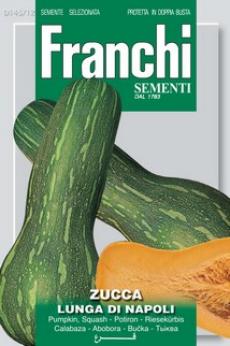
Winter Squash, Zucca Lunga Di Napoli
Squash, Zucca Lunga Di Napoli Winter Squash Mid-late. *Heritage Variety* also known as Piena di Napoli. Very large fruits, ranging from 30 to 70 pounds! It has a cylindrical shape like a butternut squash, with a cavity only at the bottom of the fruit. Grey-green skin with orange stripes when mature. The flesh is dark orange and dense. Stores well. Flavor is delicate — great for gnocchi!
The same shape as a butternut squash, but mottled green outside with thin skin, yellow flesh and a delicate flavor. Can grow to 3 feet in length! The Neapolitan long squash is also called the Neapolitan full squash. It is traditionally grown in the Campania region of Italy. The root system is fibrous, branched and shallow. The leaves are kidney-shaped with 5-6 lobes, and are dark green in color with lighter streaks and robust barbs. The flowers have a deep yellow corolla; the male flowers develop first and are characterized by a long stalk, while the female ones have a short stalk that holds the fruit.,
The fruit is a cucurbit shaped like a club, curved and swollen at the apex. The skin is smooth, thin and light or dark green. It is completely full of red-orange colored pulp that is firm and sweet with a musky flavor. The long squash is a vegetable that is well-adapted to different soil types, and can be grown even in clay soils that are well-structured, though it prefers deep soils that are cool, well-drained and rich in organic matter. The growing cycle is spring/summer. The Neapolitan long squash is sown directly in the field between April and May. Harvest takes place from the end of July to September and, if the squash are kept well-ventilated, shaded, and protected from frost, they will stay fresh for several months. It can be eaten raw, in salads, pickled, steamed or baked in the oven, and can be used in both savory and sweet dishes.
The squash, originally from Central America, was one of the first vegetables, together with the potato and the tomato, to be imported into Europe after the discovery of America. The origin of this cultivation is identified in the Agro Nocerino-Samese region, and has become widespread throughout the gardens in the province of Naples. The Neapolitan long squash is at risk of disappearing since it is mainly grown in personal gardens.
Approximately 7-15 seeds per gram.
